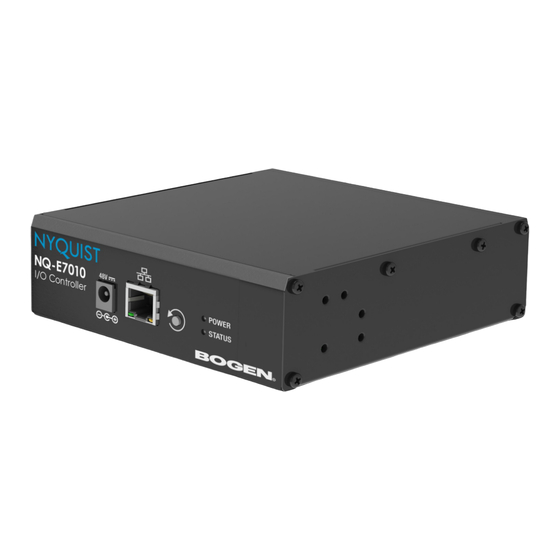Summary of Contents for Bogen NQ-E7010
- Page 1 NQ-E7010 Input/Output Controller Configuration Manual 2019 Bogen Communications, Inc. All rights reserved. 740-00017G 190215...
-
Page 3: Table Of Contents
Contents Configuring the Nyquist Input/Output (I/O) Controller .......... 1 Using the Dashboard................3 Updating Firmware ...................4 Setting Network Tab Parameters ............6 Setting Configuration Tab Parameters ..........9 Accessing Log Files................11... -
Page 5: Configuring The Nyquist Input/Output (I/O) Controller
Configuring the Nyquist Input/ Nyquist Input/ Output (I/O) Controller The NQ-E7010 I/O Controller allows Nyquist to recognize third-party switch contact closures and to provide external circuits. Configuration rules can be set for each input and output port on this appliance, so, for example, you can set a rule that if a contact is opened than an alarm sounds. - Page 6 Link icon. Figure 1, Nyquist Appliance Login Step 2 At the Nyquist Appliance - Login page, enter username and password, and then select Login. The default username is admin; the default password is bogen.
-
Page 7: Using The Dashboard
The dashboard for the selected appliance appears. Figure 2, I/O Controller Dashboard Using the Dashboard The dashboard displays the following read-only fields: Table 1, Appliance Dashboard Read-Only Fields Device Type Identifies the physical device used by the station. Serial Number Identifies the serial number for the device. -
Page 8: Updating Firmware
The dashboard also contains the following buttons: Table 2, Appliance Dashboard Buttons Dashboard Refreshes the dashboard. Configuration Set- Accesses the Configuration Settings page where you can either manually set various tings options, such as the SIP Username, or select to receive configuration settings from the server. - Page 9 required. You can also use this page to restore factory settings and to reboot the appliance. Note: A Nyquist appliance connected to the Nyquist network receives a config- uration file from the Nyquist server that includes the latest firmware available from the server.
-
Page 10: Setting Network Tab Parameters
Update Firmware button. Select this button if you want to update the appliance’s firmware to the new version. Step 3 If you want to return your appliance to its original state (undoing firmware updates), select Restore Factory Settings. Step 4 Select Reboot Appliance to restart your appliance. - Page 11 Figure 4, Network Settings Network settings are described in the following table: Table 3, Network Settings Static IP Identifies the fixed IP address assigned to the appliance by a system administra- tor. Netmask Identifies the subnetwork subdivision of an IP network.
- Page 12 Table 3, Network Settings (Continued) Gateway Identifies the address, or route, for the default gateway. VLAN ID Identifies the Virtual Local Area Network (VLAN) for this appliance. Values range from 0 to 4094. VLAN Priority Identifies the priority of the network traf- fic on the VLAN.
-
Page 13: Setting Configuration Tab Parameters
Setting Configuration Tab Parameters The easiest way to configure Nyquist appliances is to obtain configu- ration settings from the Nyquist server by selecting Get Configura- tion From Server. However, you can manually configure an appliance through the appliance’s Web UI. Note: Manual configuration will be overwritten by the server once the appli- ance is connected and discovered by the server. - Page 14 Figure 5, Appliance Configuration Settings The following table describes the Configuration tab settings: Table 4, Configuration Settings Web Username Provide a web username for this appli- ance. Web Password Provide a web password for logging into the appliance. Web Confirm Pass- Re-enter the password used to log into the appliance.
-
Page 15: Accessing Log Files
Table 4, Configuration Settings (Continued) SIP Username Provide the username used for Session Initiation Protocol (SIP) device registra- tion. SIP Password Provide the password used for SIP device registration. SIP Confirm Pass- Re-enter the password used for SIP device registration. word Server Identifies the IP address of the Nyquist... - Page 16 Figure 6, Logs Available logs are described in the following table: Table 5, Logs Description alternatives.log Contains information by the update-alternatives, which maintain symbolic links determining default com- mands. auth.log Contains system authorization information, including user logins and authentication methods that were used.
- Page 17 Table 5, Logs (Continued) Description dmesg Contains kernel ring buffer information. When the sys- tem boots up, the screen displays information about the hardware devices that the kernel detects during the boot process. These messages are available in the ker- nel ring buffer, and whenever a new message comes, the old message gets overwritten.






Need help?
Do you have a question about the NQ-E7010 and is the answer not in the manual?
Questions and answers